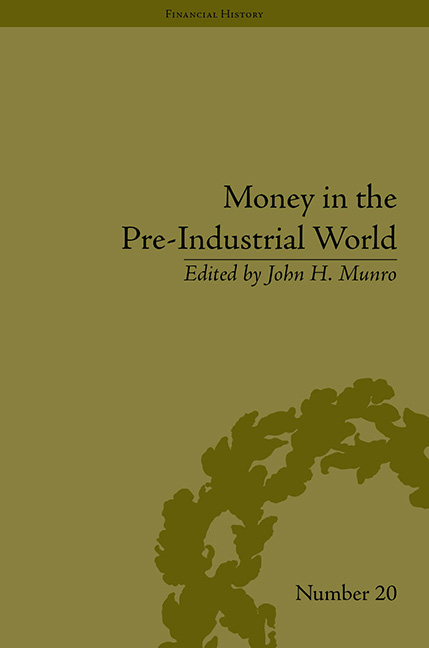Book contents
- Frontmatter
- CONTENTS
- List of Figures and Tables
- List of Contributors
- Introduction
- 1 The Technology and Economics of Coinage Debasements in Medieval and Early Modern Europe: with Special Reference to the Low Countries and England
- 2 From Aurelian to Diocletian: Financing Imperial Recovery by Coinage Debasements and Fiduciary Currencies
- 3 The Making of a Gold Standard: The Ducat and its Offspring, 1284–2001
- 4 Debasement of the Coinage and its Effects on Exchange Rates and the Economy: in England in the 1540s, and in the Burgundian-Habsburg Netherlands in the 1480s
- 5 The Amsterdam Wisselbank's Innovations in the Monetary Sphere: The Role of ‘Bank Money’
- 6 Silver in England 1600–1800: Coinage Outputs and Bullion Exports from the Records of the London Tower Mint and the London Company of Goldsmiths
- 7 The Burdens of Tradition: Debasements, Coinage Circulation and Mercantilist Public Policy Debates in Seventeenth-Century Aragon
- 8 Money or Export Commodity for Asia? American Silver in the Markets of Mexico, Castile and Amsterdam from the Sixteenth to the Eighteenth Century
- 9 Cacao Beans in Colonial México: Small Change in a Global Economy
- 10 Precious Metals, Debasements and Cowrie Shells in the Medieval Indian Monetary Systems, c. 1200–1575
- Notes
- Index
9 - Cacao Beans in Colonial México: Small Change in a Global Economy
- Frontmatter
- CONTENTS
- List of Figures and Tables
- List of Contributors
- Introduction
- 1 The Technology and Economics of Coinage Debasements in Medieval and Early Modern Europe: with Special Reference to the Low Countries and England
- 2 From Aurelian to Diocletian: Financing Imperial Recovery by Coinage Debasements and Fiduciary Currencies
- 3 The Making of a Gold Standard: The Ducat and its Offspring, 1284–2001
- 4 Debasement of the Coinage and its Effects on Exchange Rates and the Economy: in England in the 1540s, and in the Burgundian-Habsburg Netherlands in the 1480s
- 5 The Amsterdam Wisselbank's Innovations in the Monetary Sphere: The Role of ‘Bank Money’
- 6 Silver in England 1600–1800: Coinage Outputs and Bullion Exports from the Records of the London Tower Mint and the London Company of Goldsmiths
- 7 The Burdens of Tradition: Debasements, Coinage Circulation and Mercantilist Public Policy Debates in Seventeenth-Century Aragon
- 8 Money or Export Commodity for Asia? American Silver in the Markets of Mexico, Castile and Amsterdam from the Sixteenth to the Eighteenth Century
- 9 Cacao Beans in Colonial México: Small Change in a Global Economy
- 10 Precious Metals, Debasements and Cowrie Shells in the Medieval Indian Monetary Systems, c. 1200–1575
- Notes
- Index
Summary
Introduction
In the early nineteenth century, the German scientist Alexander von Humboldt visited New Spain, then still part of the Spanish Empire but soon to become the independent nation of Mexico. His book about the economy of Mexico contains a wealth of information about the general economy of the viceroyalty, including an extensive study of silver production with detailed observations about mining operations, production figures, taxation, coinage at the mint and global silver trade. Mexico was at the time the largest silver producer in the world and the Mexican peso was an international currency. Along with the precious-metal coinages, introduced by imperial authorities, cacao or cocoa beans facilitated exchanges of lesser values, and could thus be called ‘small change’, in terms of modern economies. But this form of ‘small change’ was of considerable antiquity, because cacao beans had been used for this purpose by the Aztecs and Mayans, long before the arrival of the Spanish conquerors. Indeed Humboldt himself observed how, in the old Aztec market of Tlatelolco, cacao beans were used as money ‘like the shells in the Maldives islands’ (i.e. cowrie shells). He also indicated that 72 cacao beans were currently exchanged for the smallest silver coin (medio real) minted in Mexico.
The Imperial Monetary System
The monetary system of the Spanish Empire from the fifteenth century to the independence of the American colonies was far from being a unified set of coins under a common institutional framework. In 1497, the Catholic Monarchs, Isabella of Castile and Ferdinand of Aragon, issued a decree (Ordenanza de Medina del Campo) establishing the basis of the Castilian monetary system that would last for centuries. Aragon itself was divided into three kingdoms, each with a somewhat different monetary system. Because Spain was located in the Venetian ducat area Ferdinand minted a similar gold coin in Valencia in 1481 under the name of excellent. In Catalonia a similar gold piece, the principat appeared in 1493 and in 1497 the excelente of Granada or ducat was issued for the kingdom of Castile. By 1500 these three main gold coins of the Spanish realm had the same value.
- Type
- Chapter
- Information
- Money in the Pre-Industrial WorldBullion, Debasements and Coin Substitutes, pp. 147 - 162Publisher: Pickering & ChattoFirst published in: 2014



